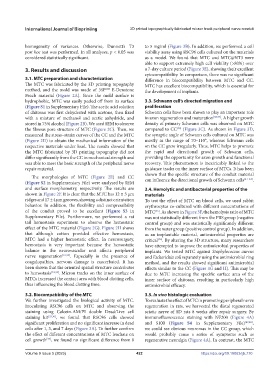Page 430 - IJB-9-5
P. 430
International Journal of Bioprinting 3D printed topographically fabricated micron track peripheral nerve conduit
homogeneity of variances. Otherwise, Dunnett’s T3 to 5 mg/ml (Figure 3B). In addition, we performed a cell
post hoc test was performed. In all analyses, p < 0.05 was viability assay using RSC96 cells cultured on the materials
considered statistically significant. as a model. We found that MTC and MTC@NT3 were
able to support extremely high cell viability (>80%) over
3. Results and discussion a 7-day culture period (Figure 3E), showing their excellent
cytocompatibility. In comparison, there was no significant
3.1. MTC preparation and characterization difference in biocompatibility between MTC and CC.
The MTC was fabricated by the 3D printing topography MTC has excellent biocompatibility, which is essential for
method, and the mold was made of 3SP E-Denstone the development of implants.
TM
Peach material (Figure 2A). Since the mold surface is
hydrophobic, MTC was easily peeled off from its surface 3.3. Schwann cell’s directed migration and
(Figure S1 in Supplementary File). The acetic acid solution proliferation
of chitosan was first dehydrated with acetone, then fixed Schwann cells have been shown to play an important role
with a mixture of methanol and acetic anhydride, and in axon regeneration and maturation [38,39] . A higher growth
stored in 75% alcohol (Figure 2B). We used SEM to observe density of primary Schwann cells was observed on MTC
the fibrous pore structure of MTC (Figure 2C). Then, we compared to CC (Figure 3C). As shown in Figure 3D,
[40]
measured the stress–strain curves of the CC and the MTC the synaptic angle of Schwann cells cultured on MTC was
(Figure 2D) to obtain the mechanical information of the mostly in the range of 70–110°, whereas Schwann cells
respective materials under load. The results showed that on the CC grew irregularly. Thus, MTC helps to promote
the MTC fabricated by 3D printing topography did not the rapid and directional growth of Schwann cells,
differ significantly from the CC in mechanical strength and providing the opportunity for axon growth and functional
was able to meet the basic strength of the peripheral nerve recovery. This phenomenon is inextricably linked to the
repair material. guidance tracks on the inner surface of MTCs. It has been
shown that the specific structure of the conduit material
The morphologies of MTC (Figure 2E) and CC [41–44]
(Figure S2 in Supplementary File) were analyzed by SEM can influence the directional growth of Schwann cells .
and surface morphometry, respectively. The results are 3.4. Hemolytic and antibacterial properties of the
shown in Figure 2F. It is clear that the MTC has 12 ± 3 μm materials
ridges and 17 ± 4 μm grooves, showing a distinct orientation To test the effect of MTC on blood cells, we used rabbit
behavior. In addition, the flexibility and compressibility erythrocytes co-cultured with different concentrations of
of the conduit proved to be excellent (Figure S3 in MTC . As shown in Figure 3F, the hemolysis ratio of MTC
[45]
Supplementary File). Furthermore, we performed a rat was not statistically different from the PBS group (negative
tail hemostasis experiment to observe the hemostatic control group) and was statistically significantly different
effect of the MTC material (Figure 2G). Figure 2H shows from the water group (positive control group). In addition,
that although cotton provided effective hemostasis, as an implantable material, antimicrobial properties are
MTC had a higher hemostatic effect. In neurosurgery, critical . By altering the 3D structure, many researchers
[46]
hemostasis is very important because the hemostatic have attempted to improve the antimicrobial properties of
balance in the neurovascular unit affects peripheral implants. We tested MTC against Staphylococcus aureus
nerve regeneration [31,32] . Especially in the presence of and Escherichia coli separately using the antimicrobial ring
coagulopathies, nervous damage is exacerbated. It has method, and the results showed significant antimicrobial
been shown that the oriented spatial structure contributes effects similar to the CC (Figure 3G and H). This may be
to hemostasis [33,34] . Micron tracks on the inner surface of due to MTC increasing the specific surface area of the
MTCs increased the contact area with blood clotting cells, inner surface of chitosan, resulting in particularly high
thus influencing the blood clotting time. antimicrobial efficacy.
3.2. Biocompatibility of the MTC 3.5. In vivo histologic evaluation
We further investigated the biological activity of MTC. To evaluate the effect of MTC in promoting peripheral nerve
Inoculating RSC96 cells on MTC and observing the regeneration in rats, we harvested the distal regenerated
staining using Calcein-AM/PI double Dead/Live cell sciatic nerve of SD rats 8 weeks after repair surgery. By
staining kit [35,36] , we found that RSC96 cells showed immunofluorescence staining with NF200 (Figure 4A)
significant proliferation and no significant increase in dead and S100 (Figure S4 in Supplementary File) [47,48] ,
cells after 1, 3, and 7 days (Figure 3A). To further confirm we could see obvious neuromas in the CC group, which
the effect of different concentrations of MTC leachate on would probably cause a series of symptoms such as
cell growth , we found no significant difference from 0 regenerative neuralgia (Figure 4A). In contrast, the MTC
[37]
Volume 9 Issue 5 (2023) 422 https://doi.org/10.18063/ijb.770

